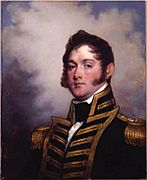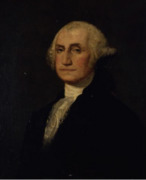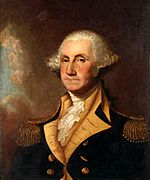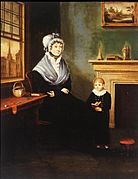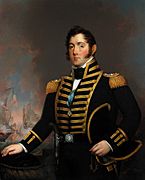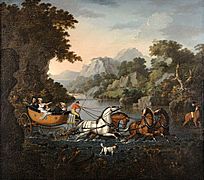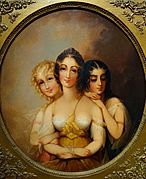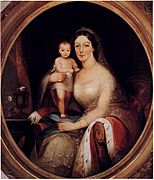Jane Stuart facts for kids
Quick facts for kids
Jane Stuart
|
|
|---|---|
| Born | 1812 Boston, Massachusetts
|
| Died | April 27, 1888 |
| Resting place | Common Burying Ground, Newport, Rhode Island |
| Nationality | American |
| Occupation | Painter |
| Known for | Portraits |
| Parent(s) | Gilbert Stuart |
Jane Stuart (born 1812, died 1888) was an American painter. She was famous for her small paintings and portraits. She especially painted many pictures of George Washington. Jane learned to paint by watching her father, Gilbert Stuart, who was also a famous artist. After her father passed away, she took on the important job of supporting her family. She first worked in Boston. Later, she moved to Newport, Rhode Island. She was the first woman to paint portraits there. In 2011, she was honored in the Rhode Island Heritage Hall of Fame.
Contents
Jane Stuart's Early Life
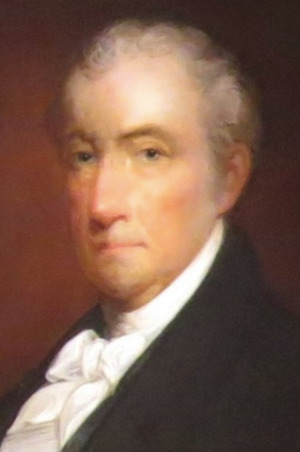
Jane Stuart was born in 1812 in Boston, Massachusetts. She was the youngest child of the well-known painter Gilbert Stuart. Her mother was Charlotte Coates Stuart. Her parents got married around September 1786.
The Stuarts had twelve children. Sadly, many of them died when they were young. Some of the children's names were Charles Gilbert, Jarvis, Emma, Elizabeth, Anne, Carlisle, Agnes Blagrove, and Jane. Charles was good at art and acting. Elizabeth became a writer. Anne lived to be 68 years old.
Jane's father faced personal challenges for many years. Despite this, the children had a somewhat normal childhood. They played music and told stories. But their home life could also be difficult at times.
Jane Stuart's Art Career
Learning to Paint and Early Work
Gilbert Stuart believed that truly talented people did not need formal lessons. So, he did not teach Jane how to paint. Instead, Jane learned by watching him work. She copied his style and also took lessons from other teachers. Her father kept her busy by having her grind paints. She also filled in the backgrounds of his paintings. Jane later said she would have liked more training from her father.
She finished many of her father's paintings that he had not completed. She also created her own art. Her father lovingly called her "boy." He thought she was a better painter than he was at her age. He wanted to send her to London to study, but he could not. Around 1820, she painted a portrait of George Washington. This painting is now at the Kemper Art Museum at Washington University in St. Louis.
Her father died in 1828. He was not good with money. When he died, his family was left with very little. The Boston Athenæum held an art show in August 1828. They showed 250 of his paintings to help raise money for his family.
Jane Stuart then opened her own art studio in Boston. She started working as an artist to support her family. After her father's death, some of her siblings needed special care.
Becoming a Well-Known Artist
After 1828, Jane got many requests for paintings. She made dozens of small and full-sized copies of her father's popular works. She was especially known for her copies of President George Washington's portraits. Her paintings of Washington showed her great skill. She was good at showing light and capturing facial features. Her copies were so good that art dealers sometimes confused them with the originals. She also copied paintings by other artists.
Jane showed her art at the Boston Athenæum starting in 1827. She often showed her works there. She also exhibited at the National Academy Museum and School in New York City until 1870.
Besides copying other artists' works, she also created her own original portraits and paintings. These showed her unique style. People said she was one of the best portrait painters in the city. This was based on her art shown at the Academy of Fine Arts.
She studied painting in New York. In 1833, she showed her art at the New York Academy of Fine Arts. Besides painting, Jane Stuart also taught art. In 1834, she painted Scene from a Novel or a Subject from Literature. This painting is now owned by Vanderbilt University in Nashville, Tennessee. She lived in New York between 1840 and 1842. During this time, she showed her works at the American Academy.
Jane and her father both worked on a portrait of Oliver Hazard Perry. This painting is at the Toledo Museum of Art. The museum says that Gilbert Stuart often left paintings unfinished. He only completed the head of this portrait. His talented 16-year-old daughter Jane finished the sky, body, and uniform after her father died. Her painting A Portrait of Commodore Oliver Hazard Perry used to belong to Brown University in Providence, Rhode Island. It is now in the collection of the Birmingham Museum of Art.
She continued to paint from the 1850s. She even made paintings from daguerreotypes, which were early photographs. Throughout her career, she also created religious paintings and everyday scenes.
Some of her paintings include Lady Macbeth, The Fortune Teller, and Morning, Noon and Night. The painting Morning, Noon and Night is at the New Britain Museum of American Art. Her portraits from this time include Alicia Boylston at the Museum of Fine Arts, Boston. Another portrait of George Washington is at the Harvard Art Museums. A portrait she made of Thomas Jefferson is at the Strawbery Banke Museum.
Stuart wrote three articles about her father for Scribner's Monthly magazine. This was between June 1876 and July 1877. She sometimes struggled with money. But she kept up appearances in Newport by selling her father's or her own paintings to people passing by.
Jane Stuart's Personal Life
Jane Stuart never married. But she enjoyed helping other people find partners. She was known for being a lively person with a great sense of humor. People said she was intelligent and playful. She loved dressing up in costumes and playing charades.
In 1831, her family moved to Newport, Rhode Island. She still kept an art studio in Boston. At this time, she supported her mother and three sisters. Her mother passed away in 1847. In August 1858, many of her paintings were destroyed when her studio caught fire. After that, she set up a studio in her family home in Newport, Rhode Island. She bought the house at 86 Mill Street in Newport in 1863.
After a short illness, Jane Stuart died on April 27, 1888. She is buried at a family monument in the Common Burying Ground in Newport, Rhode Island.
Legacy and Recognition
Jane Stuart is known as the first woman portrait painter in Newport. She was inducted into the Rhode Island Heritage Hall of Fame in 2011. Some of her artworks are part of the collection at the Gilbert Stuart Museum.
An art show featuring her and her father's original works was held at the Gilbert Stuart Museum in Saunderstown, Rhode Island. This show ran from June to October 2016. Her works in the exhibition included two portraits she made of her father. It also included portraits of George and Martha Washington.
Her artist files and photos of her works are kept at the Smithsonian American Art Museum and the Library of the Smithsonian American Art Museum and United States. These were collected from art curators, galleries, and dealers.
Gallery
-
"Portrait of Oliver Hazard Perry", Toledo Museum of Art
-
George Washington, circa 1820, Kemper Art Museum, Washington University in St. Louis
-
Oliver Hazard Perry, c. 1857
-
Coach Fording a Stream, c. 1825-1830, Wadsworth Atheneum, Hartford, Connecticut
-
Morning, Noon and Night, c. 1830-1860, oil on wood panel, New Britain Museum of American Art


